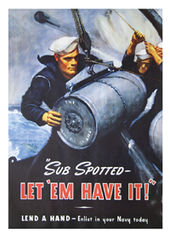- McClelland Barclay
-
McClelland Barclay (1891–1942) was an American painter of pin-up art. Born in St. Louis in 1891, Barclay studied first at the Art Institute of Chicago, then later at the Art Students League in New York City, where he studied under George Bridgman and Thomas Fogarty (artist). By the age of 21, Barclay's work had been published in The Saturday Evening Post, Ladies' Home Journal, and Cosmopolitan.
During World War I he was awarded a prize by the Committee on National Preparedness in 1917 for his poster "Fill the Breach." The next year, he designed naval camouflage under the direction of William Mackay, Chief of the New York District Emergency Fleet Corporation.[1]
During the 1920s and 1930’s, McClelland Barclay’s images were selected for use by art directors for the nation’s most popular periodicals including Colliers, Country Gentleman, Redbook, Pictorial Review, Coronet, Country Life, Saturday Evening Post, The Ladies’ Home Journal, Cosmopolitan, and a host of movie magazines. He began painting movie poster art for Hollywood studios during the 1930s as well, and was considered a superstar in the film industry.
In 1930, the General Motors selected McClelland Barclay’s ‘Fisher Body Girl’ for a series of advertisements, and she quickly became as popular as ‘The Gibson Girl’ and ‘The Christy Girl’. He used his wife, just 19 years old, as the model for the iconic Fisher Autobody image. She later appeared in magazine advertisements and was so well published with her languid body plastered across the country on billboards, that she was recognized wherever she went. He also illustrated advertisements for the A & P, Eaton Paper Company, Elgin Watches, Humming Bird Hosiery, and Lever Brothers, amongst others. His fashionable women for General Motors' "Body by Fisher" advertising campaign made his work recognizable to virtually every magazine reader in the United States. He also illustrated advertisements for Whitman's Chocolates, Texaco, and Camel and Chesterfield brand cigarettes.
Barclay did not limit himself to painting. In the late 1930s, Barclay set up a small company to reproduce jewelry and fabricate utilitarian figures for ashtrays, bookends, desk sets, lamps, and other articles for home and office use. These products were fabricated out of cast grey metal with a thick bronze plate finish and they retailed for just a few dollars.
In June 1938, he was appointed Assistant Naval Constructor with the US Naval Reserve. In mid-1940, Barclay prepared experimental camouflage designs for Navy combat aircraft, but evaluation tests revealed that pattern camouflage was of little use for aircraft. Within weeks of the Japanese attack on Pearl Harbor, Barclay completed the first of many recruiting posters for the Navy.
Appointed a Lt. Commander, Barclay worked on further camouflage assignments until 1942, when he was reported missing after the LST he was aboard was torpedoed in the Solomon Islands.
See also
- Pin-up girl
- List of pinup artists
Notes
References
- The Great American Pin-Up, by Charles G. Martignette and Louis K. Meisel, ISBN 3-8228-1701-5
- The Illustration House bio of McClelland Barclay.
External links
Categories:- 1891 births
- 1942 deaths
- American illustrators
- Pin-up artists
- School of the Art Institute of Chicago alumni
- American military personnel killed in World War II
- United States Navy officers
- Texaco
Wikimedia Foundation. 2010.



